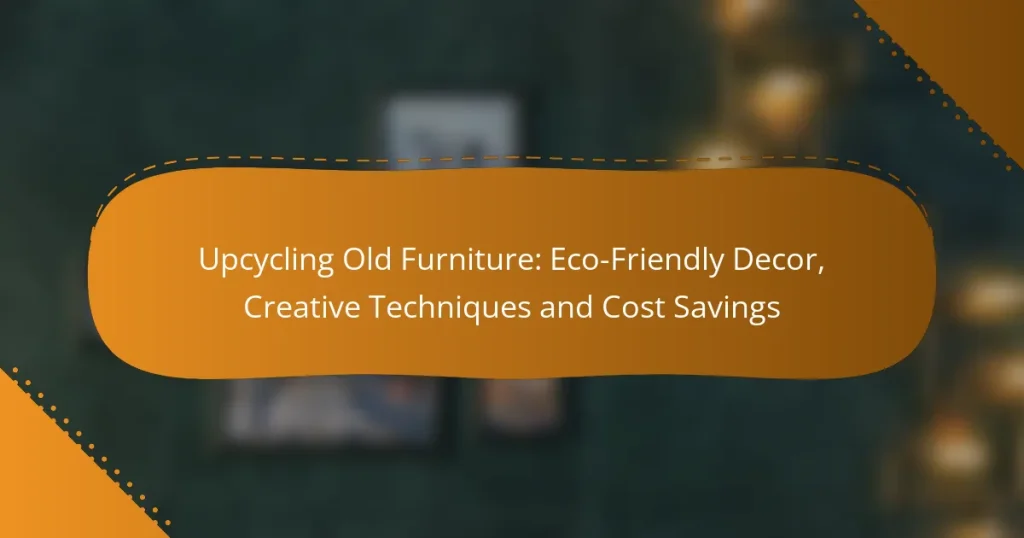Upcycling old furniture is a sustainable and cost-effective way to refresh your home decor while minimizing waste. By creatively repurposing items, you can transform outdated pieces into stylish, functional treasures using eco-friendly materials and techniques. This not only saves money but also allows for personal expression and a unique touch in your living space.

How can upcycling old furniture save money?
Upcycling old furniture can significantly reduce costs by repurposing items instead of buying new ones. This approach not only saves money but also promotes sustainability and creativity in home decor.
Reduced material costs
By upcycling, you can avoid the high prices associated with new furniture materials. Instead of purchasing new wood, fabric, or hardware, you can often use what you already have or source inexpensive materials from thrift stores or garage sales.
For instance, a simple coat of paint or new upholstery can breathe new life into an old chair, costing only a fraction of what a new chair would. This method can lead to savings of 50% or more compared to buying new furniture.
Increased resale value
Upcycled furniture can fetch a higher price on the resale market compared to its original state. Unique, creatively transformed pieces often attract buyers looking for distinctive decor options.
For example, a vintage dresser that has been refinished and updated with modern hardware might sell for double its original price. This increase in resale value can offset the initial investment in materials and time spent on the project.
DIY project savings
Taking on DIY upcycling projects can save you labor costs associated with hiring professionals. Many upcycling tasks, such as sanding, painting, or reupholstering, can be done at home with minimal tools.
Additionally, online tutorials and community workshops can provide guidance, making it easier to learn new skills without incurring extra costs. Investing time in DIY can lead to savings of hundreds of dollars compared to purchasing ready-made furniture.

What are creative techniques for upcycling furniture?
Creative techniques for upcycling furniture include various methods that transform old pieces into functional and stylish items. These techniques not only enhance the aesthetic appeal but also promote sustainability by reducing waste.
Painting and refinishing
Painting and refinishing are popular methods for revitalizing old furniture. A fresh coat of paint can completely change the look of a piece, while refinishing restores its original beauty by removing scratches and imperfections. Choose non-toxic paints and finishes to maintain an eco-friendly approach.
When painting, consider using chalk paint for a matte finish or spray paint for a smooth application. For refinishing, sanding and applying a new stain can enhance the wood’s natural grain. Always test a small area first to ensure desired results.
Reupholstering
Reupholstering involves replacing the fabric on upholstered furniture, giving it a new look and feel. This technique is ideal for chairs and sofas that have good structural integrity but outdated or damaged fabric. Select durable, eco-friendly materials to align with sustainable practices.
Begin by removing the old fabric and padding, then cut new fabric to size, ensuring to leave extra for tacking. Use a staple gun for a secure fit and consider adding new foam for enhanced comfort. This method can significantly extend the life of your furniture.
Repurposing for new functions
Repurposing furniture involves transforming items into something entirely different, providing new functionality. For example, an old dresser can become a TV stand, or wooden pallets can be converted into garden planters. This approach not only saves money but also sparks creativity.
When repurposing, think about the potential uses of each piece. Ensure that any modifications are safe and practical. Simple tools and materials can help in making these transformations, and online tutorials can provide guidance for various projects.

What eco-friendly materials can be used in upcycling?
Eco-friendly materials for upcycling include non-toxic paints, reclaimed wood, and natural fabrics. These materials not only reduce environmental impact but also enhance the aesthetic appeal of your furniture projects.
Non-toxic paints
Non-toxic paints are essential for upcycling furniture, as they minimize harmful emissions and are safer for indoor use. Look for paints labeled as low-VOC (volatile organic compounds) or water-based, which are better for the environment and human health.
When choosing non-toxic paints, consider options like chalk paint or milk paint, which are popular for their ease of use and ability to adhere to various surfaces. Always check for certifications, such as Green Seal or Greenguard, to ensure the paint meets eco-friendly standards.
Reclaimed wood
Reclaimed wood is a sustainable choice for upcycling, as it repurposes old timber instead of using new resources. This material often has unique character and history, making it a stylish option for furniture projects.
When sourcing reclaimed wood, look for local suppliers or salvage yards to reduce transportation emissions. Ensure the wood is free from harmful chemicals, such as lead paint or pesticides, by asking for any relevant documentation or testing results.
Natural fabrics
Natural fabrics, such as cotton, linen, and jute, are excellent for upholstery and soft furnishings in upcycled furniture. These materials are biodegradable and often produced with fewer chemicals compared to synthetic options.
When selecting natural fabrics, consider their durability and ease of cleaning. Organic options are preferable, as they are grown without harmful pesticides. Check for certifications like GOTS (Global Organic Textile Standard) to ensure the fabric meets eco-friendly criteria.

What are the best tools for upcycling furniture?
The best tools for upcycling furniture include a mix of power tools, hand tools, and painting supplies that facilitate cutting, assembling, and finishing projects. Selecting the right tools can enhance efficiency and improve the quality of your upcycled pieces.
Power tools for cutting
Power tools are essential for efficiently cutting wood and other materials during the upcycling process. A circular saw is versatile for straight cuts, while a jigsaw is ideal for intricate shapes and curves. For smaller projects, a rotary tool can be handy for detailed work.
When using power tools, always prioritize safety by wearing protective gear such as goggles and gloves. Ensure your workspace is clear and well-lit to avoid accidents.
Hand tools for assembly
Hand tools are crucial for assembling your upcycled furniture pieces. A good set of screwdrivers, a hammer, and a tape measure are foundational tools that every upcycler should have. Additionally, a level is important for ensuring that your furniture is stable and properly aligned.
Consider investing in a quality set of clamps to hold pieces together while the glue dries or while you secure screws. This can significantly improve the durability of your finished product.
Painting supplies
Painting supplies are vital for giving your upcycled furniture a fresh look. Start with a high-quality primer to ensure better paint adhesion and durability. Choose paints that are suitable for furniture, such as chalk paint or acrylic, which offer a variety of finishes and colors.
Don’t forget brushes and rollers for application, as well as drop cloths to protect your workspace. For a professional finish, consider using a spray gun, but be sure to follow safety guidelines and work in a well-ventilated area.

How to choose the right furniture for upcycling?
Choosing the right furniture for upcycling involves evaluating its condition, design potential, and suitability for your space. Focus on pieces that are structurally sound and have a style that can be enhanced or transformed to fit your decor needs.
Assessing structural integrity
Start by examining the furniture for any signs of damage, such as loose joints, broken parts, or significant wear. A solid frame is essential; if the structure is compromised, it may not be worth the effort or cost to upcycle.
Check for stability by gently shaking the piece and inspecting joints for movement. If repairs are needed, consider whether you have the skills or resources to fix them, as this can impact your overall budget.
Identifying design potential
Look for furniture with unique shapes, interesting details, or classic styles that can be easily updated. Pieces with simple lines are often more versatile and can be transformed with paint, new hardware, or upholstery.
Consider how the furniture will fit into your existing decor. A vintage dresser can become a statement piece with a fresh coat of paint, while an old chair can be reupholstered to match your aesthetic. Envision the final look before you start.
Considering size and space
Measure the area where you plan to place the upcycled furniture to ensure it fits well without overwhelming the space. Consider both the dimensions and the scale of the piece in relation to other items in the room.
Think about functionality as well; a large coffee table might be perfect for a spacious living room but could clutter a smaller area. Aim for a balance between style and practicality to create a harmonious environment.


